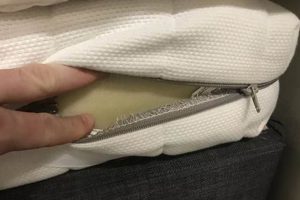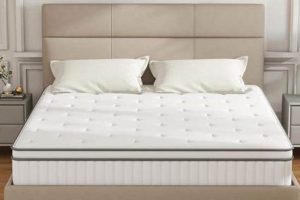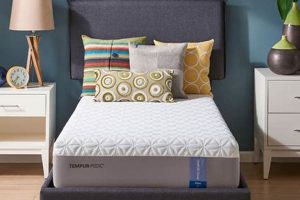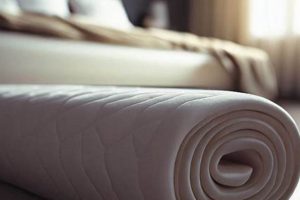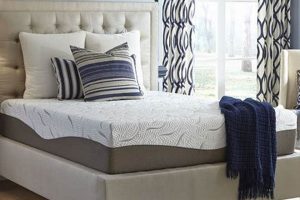These sleeping surfaces represent two popular categories in the realm of modern bedding. One type integrates a support core of innerspring coils with layers of foam, latex, or other materials to provide both responsiveness and contouring. The other relies entirely on viscoelastic foam, known for its ability to conform closely to the sleeper’s body, distributing weight and reducing pressure points.
The rise in popularity of these mattress designs reflects a growing consumer demand for personalized comfort and enhanced sleep quality. Their development represents a significant departure from traditional innerspring mattresses, offering improved motion isolation, pressure relief, and overall sleep experience. This evolution has been driven by advancements in material science and a deeper understanding of the relationship between sleep posture and spinal alignment.
The following sections will delve into the specific characteristics of these mattress types, examining their construction, performance attributes, and suitability for different sleep preferences and needs. Factors such as material composition, firmness levels, and temperature regulation capabilities will be analyzed to provide a comprehensive overview of each option.
Essential Considerations
Selecting the appropriate sleep surface requires careful evaluation of individual needs and preferences. The following recommendations are intended to guide prospective buyers through the decision-making process, focusing on key factors that influence sleep quality and overall satisfaction.
Tip 1: Assess Individual Sleep Style. Side, back, and stomach sleepers require varying degrees of support and contouring. Side sleepers typically benefit from enhanced pressure relief in the shoulder and hip regions, while back sleepers often require firmer support for optimal spinal alignment. Stomach sleepers generally need a very firm surface to prevent excessive sinking and potential back strain.
Tip 2: Evaluate Firmness Levels. Mattress firmness is subjective, but generally ranges from plush to extra firm. Consider body weight and personal preference when selecting a firmness level. Lighter individuals may find softer options more comfortable, while heavier individuals may require firmer support.
Tip 3: Consider Temperature Regulation. Memory foam, while offering excellent contouring, can sometimes trap heat. Individuals prone to overheating should consider options with cooling technologies, such as gel-infused foam or breathable cover materials. Hybrid models, with their innerspring core, often provide better airflow.
Tip 4: Research Material Composition. The quality and density of foam layers significantly impact durability and performance. Look for CertiPUR-US certification to ensure that the foam meets specific standards for content, emissions, and durability. Similarly, consider the coil gauge and construction of the innerspring system in hybrid models.
Tip 5: Prioritize Motion Isolation. If sharing the bed with a partner, motion isolation is a crucial factor. Memory foam excels at absorbing movement, preventing disturbances from one sleeper to the other. Hybrid models with individually wrapped coils also offer good motion isolation.
Tip 6: Review Warranty and Trial Period. Reputable manufacturers typically offer warranties and trial periods, allowing buyers to test the product in their own homes before committing to a purchase. Carefully review the terms and conditions of these policies.
Tip 7: Read Customer Reviews. While subjective, customer reviews can provide valuable insights into the real-world performance and durability of different models. Consider reviews from multiple sources and look for common themes and trends.
By carefully considering these factors, individuals can make informed decisions and select a sleeping surface that aligns with their specific needs, preferences, and sleep goals. The result is likely to be improved sleep quality and enhanced overall well-being.
The subsequent sections will provide a detailed comparison of these two categories, highlighting their strengths and weaknesses and guiding readers toward the optimal choice for their individual circumstances.
1. Support Core
The support core constitutes a fundamental distinction between hybrid and memory foam mattresses. In a hybrid model, the core is generally comprised of an innerspring system, often utilizing pocketed coils. This configuration provides a degree of responsiveness and airflow not typically found in all-foam constructions. The coil gauge and coil density within the innerspring system directly impact the mattress’s overall firmness and support. A higher coil count and lower gauge (thicker wire) usually correlate with a firmer, more supportive surface. The innerspring core’s primary function is to provide foundational support, preventing excessive sagging and maintaining spinal alignment, particularly for heavier individuals.
Conversely, a memory foam mattress relies on a high-density foam layer as its support core. The density of this foam layer is a critical determinant of its durability and ability to resist compression over time. Higher-density foams tend to maintain their shape and support capabilities for a longer duration compared to lower-density alternatives. Furthermore, the support core in a memory foam mattress contributes significantly to its overall feel. While the upper layers of memory foam provide contouring and pressure relief, the support core prevents the sleeper from sinking too deeply into the mattress, which could lead to discomfort or difficulty changing positions.
Understanding the support core’s function in each mattress type is paramount for selecting the appropriate model. The innerspring core of a hybrid design generally offers greater edge support and facilitates better airflow, addressing concerns about heat retention. The foam core of a memory foam mattress prioritizes motion isolation and can provide more consistent support across the entire surface. The choice hinges on individual preferences regarding firmness, temperature regulation, and desired level of responsiveness.
2. Conforming Ability
Conforming ability, in the context of bedding, refers to a mattress’s capacity to mold to the sleeper’s body contours. This characteristic is a defining feature that distinguishes memory foam and hybrid mattresses from traditional innerspring models. The enhanced conforming ability of these materials directly correlates with improved pressure relief, particularly at points of contact like the shoulders and hips. Without adequate conforming ability, localized pressure can impede circulation, leading to discomfort and disrupted sleep. For example, a side sleeper on a mattress with insufficient conforming ability may experience pressure buildup in the shoulder, resulting in tossi
ng and turning. The composition and density of the materials directly influence this attribute; higher density memory foam generally offers superior conforming ability compared to low-density options or the innerspring cores of hybrid models alone.
The practical significance of understanding conforming ability extends beyond mere comfort. Proper spinal alignment is contingent upon a mattress’s ability to adapt to the sleeper’s unique body shape. A mattress with exceptional conforming ability can maintain the natural curvature of the spine, reducing the risk of back pain. In contrast, a surface that is too firm or unyielding can force the spine into an unnatural position, exacerbating existing back problems or contributing to new ones. The design of hybrid mattresses attempts to bridge the gap between the conforming benefits of foam layers and the support provided by an innerspring system. The effectiveness of this combination is dependent on the specific configuration and the quality of the materials used in each layer. For instance, a hybrid mattress with a thin comfort layer of low-density foam may not provide sufficient conforming ability to adequately alleviate pressure points.
In summary, conforming ability is a crucial performance characteristic of memory foam and hybrid mattresses. Its influence on pressure relief and spinal alignment directly affects sleep quality and overall well-being. While memory foam is generally recognized for its superior conforming properties, hybrid models can offer a balanced approach, combining conforming comfort with the support and responsiveness of innerspring coils. The optimal choice depends on individual preferences and specific sleep needs, but a thorough understanding of conforming ability is essential for making an informed decision. Challenges in assessing this characteristic often arise from subjective perceptions of comfort and the variability in material composition among different mattress models. Further research and careful consideration of individual requirements are recommended.
3. Temperature Regulation
Temperature regulation is a critical factor in the selection of a sleeping surface, directly influencing sleep quality and overall comfort. The materials used in mattress construction significantly impact heat retention and dissipation, with memory foam and hybrid designs exhibiting distinct thermal properties that warrant careful consideration.
- Memory Foam Density and Airflow
Traditional memory foam is known for its dense structure, which, while providing exceptional conforming ability, can restrict airflow and trap body heat. This can lead to discomfort for individuals prone to overheating. The density of the foam directly correlates with its heat retention capacity; higher density foams tend to retain more heat compared to lower density options. Open-cell memory foam and gel-infused memory foam represent attempts to mitigate this issue by promoting airflow and dissipating heat more effectively. However, their performance varies, and the extent of temperature regulation improvement remains a key consideration for potential buyers.
- Hybrid Mattress Construction and Ventilation
Hybrid mattresses, incorporating an innerspring core, generally offer better ventilation compared to all-foam designs. The spaces between the coils facilitate airflow, allowing heat to dissipate more readily. The specific design of the innerspring system, such as the use of individually wrapped coils, can further enhance airflow. Additionally, the type of materials used in the comfort layers of a hybrid mattresssuch as latex or breathable foamscan contribute to improved temperature regulation. However, the presence of memory foam in the comfort layers can still impede airflow to some extent, requiring a balanced approach in material selection.
- Cover Materials and Breathability
The mattress cover plays a crucial role in temperature regulation by influencing the rate of heat transfer between the sleeper and the mattress. Breathable materials like cotton, Tencel, and bamboo allow for better airflow and moisture wicking, helping to keep the sleeper cool and dry. Conversely, synthetic materials can restrict airflow and trap heat, exacerbating temperature regulation issues. The weave and construction of the cover also affect its breathability, with looser weaves generally promoting better airflow. Active cooling technologies, such as phase-change materials incorporated into the cover, represent a more advanced approach to temperature regulation, but their effectiveness and longevity should be carefully evaluated.
- Environmental Factors and Individual Physiology
Ambient room temperature and humidity levels significantly influence the perceived temperature of a mattress. A mattress that performs well in a cool, dry environment may not be as effective in a warm, humid setting. Furthermore, individual physiology plays a role in temperature regulation; factors such as metabolic rate and body weight can affect the amount of heat generated during sleep. Individuals who naturally run hot may require mattresses with superior temperature regulation capabilities compared to those who are less sensitive to heat. The interplay between environmental factors, individual physiology, and mattress materials determines the overall sleep experience.
In conclusion, effective temperature regulation is a multifaceted challenge in mattress design. While memory foam offers exceptional conforming ability, its inherent heat retention properties necessitate careful consideration of mitigating strategies. Hybrid mattresses, with their innerspring cores and potential for breathable comfort layers, generally offer better ventilation. The selection of cover materials and the influence of environmental factors further complicate the equation. Ultimately, the optimal choice hinges on a thorough assessment of individual sleep preferences, physiological characteristics, and environmental conditions to ensure a comfortable and restful night’s sleep.
4. Motion Isolation
Motion isolation, the ability of a mattress to minimize the transfer of movement from one area to another, represents a critical performance characteristic, particularly for individuals sharing a bed. The structural composition of both hybrid and memory foam mattresses directly influences their motion isolation capabilities, albeit through differing mechanisms. Memory foam mattresses, constructed primarily of viscoelastic foam, excel in absorbing motion due to the foam’s inherent damping properties. When one area of the mattress is subjected to movement, the foam compresses and absorbs the energy, preventing it from propagating across the surface. This results in minimal disturbance to a sleeping partner. For instance, if one partner frequently tosses and turns, the other partner is less likely to be awakened by the resulting motion on a memory foam mattress. The density and thickness of the memory foam layers directly correlate with the degree of motion isolation achieved; thicker, higher-density foam provides superior motion isolation compared to thinner, lower-density options. The practical significance of this feature is evident in improved sleep quality for both partners, fostering a more restful and uninterrupted sleep experience.
Hybrid mattresses, which combine innerspring systems with layers of foam, offer a different approach to motion isolatio
n. The effectiveness of motion isolation in a hybrid model depends largely on the type of innerspring system used. Individually pocketed coils, where each coil is encased in fabric, provide better motion isolation compared to interconnected coil systems. Because each coil moves independently, the transfer of motion is minimized. The presence and composition of the foam layers atop the innerspring system also contribute to motion isolation; thicker, denser foam layers further dampen motion transfer. For example, a hybrid mattress with individually pocketed coils and a thick layer of memory foam can provide motion isolation comparable to that of a traditional memory foam mattress. However, a hybrid model with interconnected coils and a thin comfort layer may exhibit greater motion transfer, potentially disrupting a sleeping partner. Real-world scenarios highlight the importance of specifying the innerspring system when considering motion isolation in hybrid mattresses. A hybrid mattress with continuous coils are prone to more motion disturbances.
In summary, motion isolation is a significant attribute influenced by mattress construction. Memory foam mattresses generally provide excellent motion isolation due to the inherent properties of the foam. Hybrid mattresses can achieve comparable levels of motion isolation with individually pocketed coils and substantial foam layers. The challenge lies in accurately assessing motion isolation performance, as manufacturers’ claims may not always reflect real-world experiences. Therefore, prospective buyers are encouraged to research the specific construction details of each mattress, paying particular attention to the type of innerspring system and the density and thickness of the foam layers. Understanding these factors is crucial for selecting a mattress that effectively minimizes motion transfer and promotes undisturbed sleep.
5. Durability
Durability, the ability of a mattress to withstand wear and maintain its structural integrity and performance characteristics over an extended period, is a paramount consideration for consumers. The lifespan of a hybrid or memory foam mattress is influenced by various factors inherent in its design and construction, necessitating careful evaluation.
- Foam Density and Degradation
The density of the foam layers within both memory foam and hybrid mattresses plays a critical role in determining their long-term durability. Higher-density foams exhibit greater resistance to compression and deformation, mitigating the risk of sagging and body impressions. Conversely, lower-density foams are more susceptible to degradation over time, leading to diminished support and comfort. Example: A memory foam mattress with a base layer density of 1.8 pounds per cubic foot may exhibit noticeable sagging within a few years, whereas a similar mattress with a base layer density of 2.5 pounds per cubic foot is likely to maintain its structural integrity for a significantly longer period. The implications are substantial, as premature degradation necessitates replacement, incurring additional cost and inconvenience.
- Coil System Integrity (Hybrid Mattresses)
For hybrid mattresses, the quality and construction of the innerspring coil system are crucial determinants of durability. Coil gauge (thickness) and coil count directly influence the level of support and resistance to sagging. Higher gauge coils (thicker wires) provide greater support and are less prone to deformation. Individually pocketed coils, while offering enhanced motion isolation, must also maintain their structural integrity to prevent uneven support. Example: A hybrid mattress with an interconnected coil system may experience premature sagging in areas of high use, compromising spinal alignment and comfort. Conversely, a hybrid mattress with a high-quality pocketed coil system is likely to maintain its support characteristics for an extended period. Proper support is crucial for back health.
- Material Fatigue and Compression Set
All mattress materials, including foam and coils, are subject to fatigue and compression set over time. Fatigue refers to the gradual weakening of the material due to repeated stress, while compression set is the permanent deformation of the material after being subjected to prolonged compression. Both phenomena contribute to a reduction in support and comfort. Example: A memory foam mattress may initially provide excellent contouring and pressure relief, but after several years of use, the foam may exhibit significant compression set, resulting in a loss of support and a less comfortable sleep surface. Manufacturers often employ techniques to mitigate these effects, such as using higher-quality materials and incorporating design features that distribute weight more evenly.
- Warranty Coverage and Limitations
Mattress warranties provide a degree of protection against manufacturing defects and premature failure, but it is crucial to understand the scope and limitations of the warranty coverage. Warranties typically cover issues such as sagging beyond a certain threshold (e.g., 1.5 inches) and broken coils, but they may not cover normal wear and tear or subjective complaints about comfort. Example: A mattress warranty may cover sagging that exceeds 1.5 inches, but it will not cover body impressions that do not meet that threshold. Furthermore, warranties often require proper mattress support and may be voided if the mattress is used on an unsuitable foundation. A clear understanding of warranty terms is essential for managing expectations and making informed purchasing decisions.
The interplay of these factors ultimately determines the lifespan of a hybrid or memory foam mattress. While high-quality materials and robust construction can significantly extend durability, all mattresses are subject to eventual degradation. Understanding the specific attributes that contribute to durability empowers consumers to make informed choices and maximize the value of their investment. Regular rotation of the mattress can help to even out wear. Comparing consumer ratings can also help to identify mattresses with low long-term durability.
Frequently Asked Questions
The following addresses common inquiries regarding the selection and performance characteristics of two prevalent types of sleeping surfaces. The information aims to clarify key differences and provide a factual basis for informed decision-making.
Question 1: What constitutes the primary distinction between hybrid and memory foam mattress constructions?
The fundamental difference lies in the core support system. A hybrid model integrates an innerspring system with layers of foam, whereas a memory foam mattress relies solely on viscoelastic foam for both support and comfort.
Question 2: Does a higher price point invariably indicate superior quality in either mattress type?
While price often reflects material quality and construction complexity, it is not a definitive indicator of suitability. Individual preferences and specific needs should guide the selection process, irrespective of cost.
Question 3: How does temperature regulation differ between the two mattress types, and what mitigations are available?
Memory foam tends to retain more heat due to its dense structure. Hybrid models, with their innerspring cores, generally offer better airflow. Mitigation strategies include gel infusions, open-cell foam, and breathable cover materials.
Question 4: To what extent does each mattress type isolate motion, and why is this feature important?
Memory foam excels at absorbing motion, minimizing disturbances for sleeping partners. Hybrid models with individually pocketed coils also offer good motion isolation. This feature enhances sleep quality and reduces partner-induced awakenings.
Question 5: What factors contribute to the overall durability and lifespan of each mattress type?
Foam density, coil gauge (for hybrids), and the quality of materials all influence durability. Higher-density foams and robust coil systems typically result in longer lifespans.
Question 6: Are there specific sleep positions or body types for which one mattress type is generally better suited than the other?
Side sleepers often benefit from the pressure relief offered by memory foam. Back sleepers may prefer the firmer support of a hybrid model. Heavier individuals generally require firmer mattresses, regardless of type.
These answers provide a foundational understanding of critical considerations. Additional research and careful assessment of individual requirements are recommended for optimal mattress selection.
The following section will summarize the key considerations and provide concluding remarks regarding these popular bedding choices.
Concluding Remarks
This exposition has examined the distinguishing characteristics, advantages, and limitations associated with the selection between a hybrid or memory foam mattress. Key considerations include support core construction, conforming ability, temperature regulation, motion isolation, and long-term durability. Each mattress type presents a unique set of performance attributes, necessitating a thorough evaluation of individual sleep preferences, physiological needs, and budgetary constraints. While memory foam prioritizes pressure relief and motion isolation, hybrid designs attempt to balance these benefits with enhanced support and ventilation. The optimal choice hinges on a comprehensive understanding of these factors and their interrelation.
The decision regarding a suitable sleeping surface should not be undertaken lightly, as it directly impacts physical health and overall well-being. Further investigation into specific models, including a review of independent assessments and warranty provisions, is strongly encouraged. The long-term implications of this choice warrant careful deliberation, promoting a more restful and restorative sleep experience.


